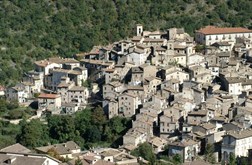Scanno
 Scanno, which is also listed among the borghi più belli d’Italia, is a renowned tourist destination on account of its lake with the same name, its nearby ski resort and the natural reserve of the Gole del Sagittario. Among its many points of interest, Scanno conserves an interesting artistic and architectural heritage in which the church of Sant’Eustachio stands out, which is also dedicated to Santa Maria di Loreto. It was built on the ruins of a medieval church, demolished in 1693. The stucco and decorations which distinguish it go back to the first decades of the eighteenth century and even in this case they are the result of the decisive intervention of artists and masters from various parts of the Italian peninsula, among them the Milanese master stucco worker Giovan Battista GianniBorn in Cuomo, Giovan Battista Gianni lived the greater part of his life in Abruzzo, where his activity is documented from 1685 to 1728. Among the first to introduce the language of the late Baroque, he affirmed himself in Abruzzo and Molise during the whole of the eighteenth century. He was active in Pescocostanzo and Scanno but his presence was attested to in various centres in Abruzzo: in Penne, Chieti, Atri, Sulmona, Città Sant’Angelo and Ortona, while his participation in the reconstruction of Santa Maria di Collemaggio in L’Aquila in the eighteenth century is doubtful., the decorator Francesco FerradiniFrancesco Ferradini belonged to a family of Lombard origin of stucco workers, sculptors and architects who were active in Abruzzo from the first half of the seventeenth century and until the middle of the following century. Among the most important exponents of the second generation, Francesco worked between the seventeenth and eighteenth centuries and his work is attested to in Pescocostanzo, Scanno and Castel di Sangro, in addition to L’Aquila. and the painter Francesco Antonio Borsillo. The latter, from Molise, constitutes the ideal example of the artist who was active in several centres in Abruzzo during the Baroque period as his presence is attested to not only in the church of Sant’Eustachio, but also in the paintings which decorate the cupola of the Collegiate Church of Pescocostanzo. In Scanno, another beautiful example of Baroque art is the chapel of San Costanzo in the parish church. Even though it conserves frescoes within it which go back to the sixteenth century, the chapel has a Baroque decorative layout which has been restored after the restoration work which took place in 1992. As an example of civil architecture Palazzo Mosca, built between the end of the seventeenth and the beginning of the eighteenth centuries, can be mentioned in which the Baroque taste is visible above all in the wing of the palace which overlooks piazza San Rocco.
Scanno, which is also listed among the borghi più belli d’Italia, is a renowned tourist destination on account of its lake with the same name, its nearby ski resort and the natural reserve of the Gole del Sagittario. Among its many points of interest, Scanno conserves an interesting artistic and architectural heritage in which the church of Sant’Eustachio stands out, which is also dedicated to Santa Maria di Loreto. It was built on the ruins of a medieval church, demolished in 1693. The stucco and decorations which distinguish it go back to the first decades of the eighteenth century and even in this case they are the result of the decisive intervention of artists and masters from various parts of the Italian peninsula, among them the Milanese master stucco worker Giovan Battista GianniBorn in Cuomo, Giovan Battista Gianni lived the greater part of his life in Abruzzo, where his activity is documented from 1685 to 1728. Among the first to introduce the language of the late Baroque, he affirmed himself in Abruzzo and Molise during the whole of the eighteenth century. He was active in Pescocostanzo and Scanno but his presence was attested to in various centres in Abruzzo: in Penne, Chieti, Atri, Sulmona, Città Sant’Angelo and Ortona, while his participation in the reconstruction of Santa Maria di Collemaggio in L’Aquila in the eighteenth century is doubtful., the decorator Francesco FerradiniFrancesco Ferradini belonged to a family of Lombard origin of stucco workers, sculptors and architects who were active in Abruzzo from the first half of the seventeenth century and until the middle of the following century. Among the most important exponents of the second generation, Francesco worked between the seventeenth and eighteenth centuries and his work is attested to in Pescocostanzo, Scanno and Castel di Sangro, in addition to L’Aquila. and the painter Francesco Antonio Borsillo. The latter, from Molise, constitutes the ideal example of the artist who was active in several centres in Abruzzo during the Baroque period as his presence is attested to not only in the church of Sant’Eustachio, but also in the paintings which decorate the cupola of the Collegiate Church of Pescocostanzo. In Scanno, another beautiful example of Baroque art is the chapel of San Costanzo in the parish church. Even though it conserves frescoes within it which go back to the sixteenth century, the chapel has a Baroque decorative layout which has been restored after the restoration work which took place in 1992. As an example of civil architecture Palazzo Mosca, built between the end of the seventeenth and the beginning of the eighteenth centuries, can be mentioned in which the Baroque taste is visible above all in the wing of the palace which overlooks piazza San Rocco.
